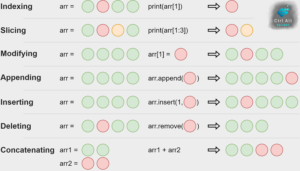Loops in Python allow you to repeat a block of code until a certain condition is met. There are two types of loops in Python: for loops and while loops. Here are examples of each type of loop:
For Loop in Python
A for loop is used to iterate over a sequence (such as a list, tuple, or string) or other iterable object. Here’s an example:
fruits = ["apple", "banana", "cherry"]
for fruit in fruits:
print(fruit)This will output:
apple
banana
cherryWhile Loop in Python
A while loop repeats a block of code as long as a certain condition is true. Here’s an example:
counter = 1
while counter <= 5:
print(counter)
counter += 1This will output:
1
2
3
4
5In both for and while loops, you can use the break statement to exit the loop early, and the continue statement to skip to the next iteration of the loop.
Bonus: Looping Through a Dictionary
When looping through a dictionary, you can use the items() method to get both the key and value of each item in the dictionary. Here’s an example:
person = {"name": "John Doe", "age": 30, "city": "New York"}
for key, value in person.items():
print(f"{key}: {value}")
This will output:
name: John Doe
age: 30
city: New YorkThis way, you don’t have to use the keys to access the values, which can make your code more readable and easier to write.
